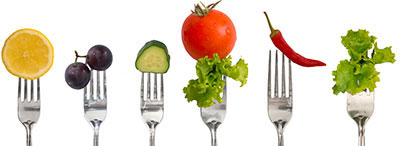Retraining Your Salty Taste Buds
When it comes to our relationship with salt, most of us have to make a change. We have become so accustomed to either eating refined foods high in sodium such as pre-packaged food, canned foods, frozen meals, condiments, deli meats, and sprinkling salt on everything we eat, that we are now deeply entrenched in the addiction. Suddenly, any food without it tastes "bland" or "unexciting."
A Healthy Approach to Salt
When we retrain our taste buds and free ourselves of this addiction, we begin to appreciate many of the wonderful foods nature has to offer for their own flavors, rather than trying to mask them in salt. Once you cut back on salt in your diet, the great news is that it takes a very short period of time for your taste buds to adjust. Once that happens, suddenly, all the high-salt foods you used to love will taste far too salty, and you will be surprised at how you scrunch up your nose at them!

Here are some tips to help you develop a healthy approach to salt. Use the same tips when cutting out other unhealthy food ingredients such as added sugar.
- Understand the Health Dangers
Understand the health dangers from eating too much salt. Excess sodium is linked to increased blood pressure, a risk factor for heart disease, and can contribute to or exacerbate kidney disease and diabetes.
Giving up excess salt can clear up many conditions that are caused by or made worse by salt. The internal structure of the body begins to normalize, and sometimes high blood pressure can disappear overnight, reducing the risk of heart disease significantly. - Cut Out the Excess
The single best method to retrain your taste buds is to completely cut out all excess salt for 30 days. This is the most powerful and most effective approach to retraining your taste buds, which will quickly begin to adjust. At the end of 30 days, adding the same amount of salt that you previously used will suddenly make your food taste FAR too salty! In fact, you will likely be shocked at how you reject the food for its salty taste. The same approach works for sugar.
When I cut out all sugar and sweeteners from drinks, and all excess salt from food for 30 days (yep, I did a double-whammy and cut both out cold turkey!), after 30 days I purchased a flavored and sugared ice-tea I was previously addicted to and literally gagged at how sweet it was! It tasted awful! And all that salt I used to put on my food completely overwhelmed it and even caused me to use a tissue to wipe it off. The result was so intense that I even water down my freshly squeezed pineapple or orange juice because in its fresh form it suddenly seemed too sweet for me. Talk about a transformation for a sugar and salt addict - and in only 30 days... - Use Added Salt Sparingly
If you add salt to your food, then add it sparingly and make sure it is a high-quality salt. Either shake it once over your food, or sprinkle a little into the palm of your hand first so that you can see exactly how much salt you are adding. Random salt cellar shaking can put out far more salt than you may realize. - Use Salt Sparingly in Recipes
In cooking recipes, begin by halving the amount of salt recommended, and go down from there. When we prepare or cook our own foods at home, we are the ones in control of how much salt we add, which is a bonus. - Salty Condiments
Watch out when using condiments such as salad dressings, relish, and ketchup, many of which are extremely high in sodium content. - Eating Out
When eating out, simply ask the waiter for your food to be prepared without salt. This way, you can control exactly how much sodium is in your food by adding a small amount, or choosing not to add any. - Grocery Shopping
When grocery shopping, pay close attention to the sodium content on the nutritional label and opt for fresh produce when possible (fruits and vegetables) as your main food items. These foods are not only highly nutritious, they are naturally very low in sodium. Canned, packaged, and frozen foods are notoriously high in sodium - look at the ingredient labels and make sure that salt is not listed. Foods that are marketed as "low fat" or "diet" are an especially big culprit as they are often over-salted to make up for the lost flavor from fats, salts, and sugars.
Avoid purchasing high-salt foods entirely. They do not belong in your cupboard. We all know of products such as potato chips where we can't eat "just one." The solution is to make sure that "just one" isn't available in the first place! By the way, the reason we cannot control popping those chips into our mouths is because they contain something called "excitotoxins," highly addictive and unhealthy food chemicals that keep us coming back for more. - Use Healthy Substitutes
Substitute salt for other natural and exciting flavors such as fresh garlic, spices, chilies/peppers, and citrus fruits such as lemon, lime, grapefruit or orange juice. Herbs and roots such as ginger, thyme, coriander, dill, and oregano can add wonderful flavor. Sherry, apple cider vinegar, and red wine can give a dash of flavor and intensity. Nutritional yeast is also a wonderful ingredient that gives a "cheesy" taste to any food or recipe it is added to.
RELATED ARTICLES
- Salt
- Health dangers of excess salt
- Sodium in natural foods
- Retraining your taste buds
- The Dirty Dozen: What they are & why you should avoid them
- What are processed and refined foods
- Additives & chemicals in our food
- Get off the diet merry-go-round
- Healthy food choices for children
- Healthy food choices for pets
- The FDA: Failure to protect our food on a mass scale
- Food pyramids & food politics



